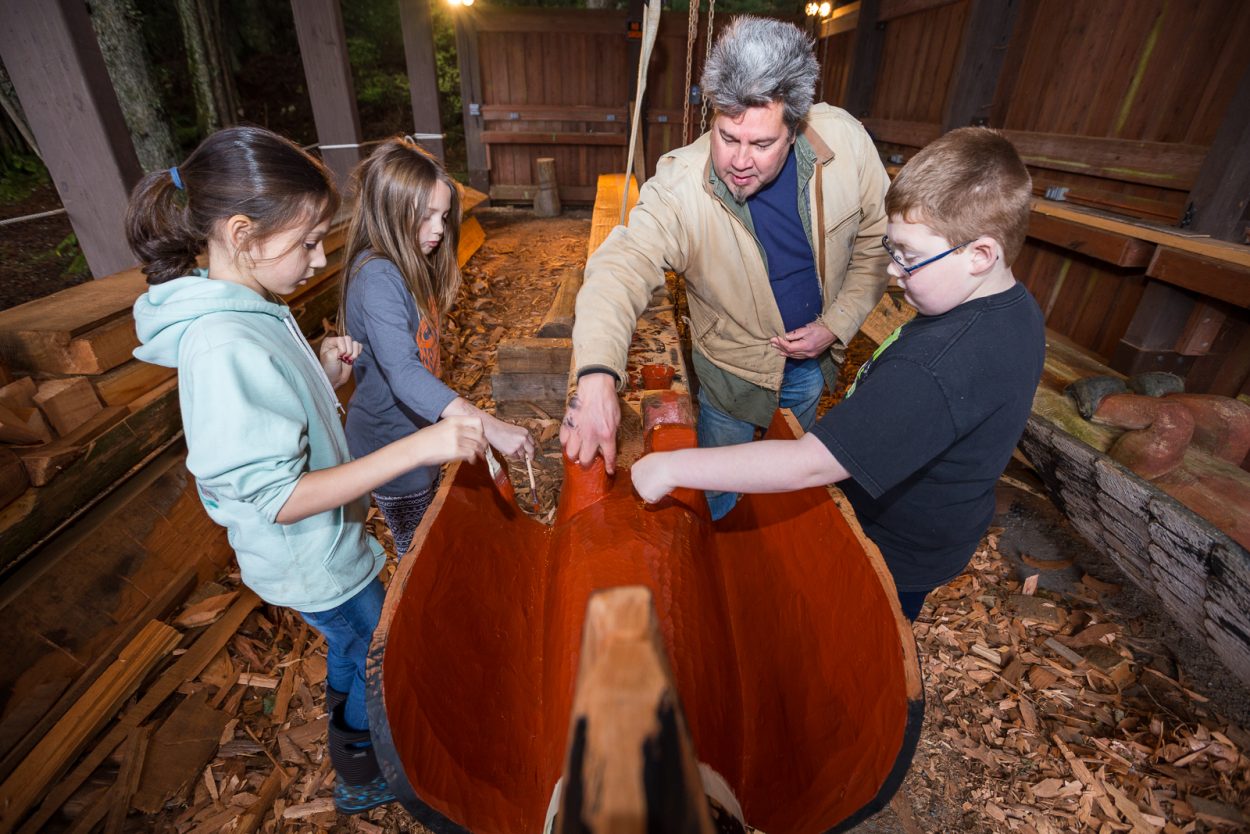
Tlingit wood carver Tommy Joseph gives painting pointers to Keet Gooshi Heen Elementary School fourth-graders who helped him with a replica of a cormorant mortuary pole for the Sitka National Historical Park. (Photo by Weston Kessler)
Sitka students had a rare opportunity this week to paint a totem pole that will be on display in Sitka National Historical Park. About a hundred fourth-graders helped Tlingit wood carver Tommy Joseph at the park with a replica of a cormorant mortuary pole, which was originally donated to the state in 1903.
Fourth-graders from Keet Gooshi Heen Elementary School were pretty impressed with master carver Tommy Joseph’s work. But not as impressed as they were with themselves.
“I’ll probably brag to my friends that I painted it, be like, ‘Oh my gosh I got to paint that,”said 9-year-old Dalila Callahan, a student in Mindy Barry’s class.
The importance of the experience was not lost on her.
“It’s pretty cool because you don’t really get the opportunity to paint it all the time,” she said.
A lot of people don’t.
Wielding brushes dipped in a deep red latex house paint, Dalila and her classmates attacked the belly of the wooden cormorant that was perched high atop a plainly carved pole.
“You know what a cormorant is?” Joseph asked. “A lot of times you see them right here out on the beach or on the rocks . I saw some yesterday out at Seamart parking lot down on the water there. It’s a black shore bird, an ocean bird.”
The students cycled through the totem pole station in small groups while the others learned about how traditional paint colors were made — sometimes with salmon roe and iron oxide. Another group heard about the significance of the totem poles and their stories from Sitka national park employees.
Much of the history of this cormorant pole is unknown, however. Joseph says a story just didn’t come with it.
“It’s a mortuary pole,” Joseph said. “It could have been the guy was from the Cormorant House or part of his clan crest.”
Alaska Territorial Governor John Brady acquired the cormorant pole from a Tlingit village in 1903, along with others in the park. Some traveled to the St. Louis world’s fair shortly after and then came to sit where they are seen today although many originals have been replicated.
“It is part of Sitka’s history now and the local native culture and it’s good for the kids to learn about that,” Joseph said.
Teacher Barry agrees. Fourth-graders in Alaska study the state’s cultural history. She says being able to help Joseph put the lessons into action.
“It’s been absolutely wonderful to tie this into our unit and talk about totems and the stories behind them and actually get their hands on and see the carving happening. Being a part of the painting is really exciting,” Barry said.
Joseph has worked with students before but never this young. And he was admittedly a little nervous about it, as it took him months to carve the pole out of a 26-foot red cedar tree. But, he had a similar opportunity when he was in elementary school that got him started on his craft.
“When I was in the third grade I got to carve on wood in class when I was 8,” he said.
That’s an experience he likes to share with people of all ages and especially kids. And he may have just inspired a new generation of wood carvers. Nine-year-old Sunny McClenahan says painting the whole thing was awesome.
“This is my first time painting a totem pole and I actually get to have an experience,” Sunny said. “I actually loved it.”
Joseph will put the finishing touches on the recreated pole and it will be raised along the trail in the park sometime after its completion.































